Most of my kids love math and art, so we were excited to review the MathArt Online 4-Class Bundle from NatureGlo’s eScience. I loved the idea of using videos and other online material to supplement my twins’ math studies, allowing them to learn about concepts that I never encountered in math class when I was in school.
If my girls had been behind in math, we would not have taken on this supplementary study just yet. However, since they are already tackling Algebra at age twelve, I decided to scale back their main curriculum work a bit to make room for MathArt.

The Bundle includes four exploration-based 6-week classes that integrate math, science, history, and the arts:
- Math Connections with the Real World
- MathArt in Ancient Cultures
- MathArt in the Arts & Sciences
- MathArt: Patterns in Nature
After browsing through the courses, we decided to start at the top of the list: Math Connections with the Real World. This class focuses on Fibonacci numbers and the Golden Ratio (also known as the Golden Mean, Golden Section, and Phi), both of which are found in nature, art, architecture, and even music.
How It’s Set Up
The course has six lessons and is designed to be completed at the rate of one each week—a very reasonable pace. Each week’s work usually starts with a Main Lesson, comprised of one or more videos featuring a PowerPoint presentation. Downloadable study guides with printable worksheets help students follow along.

The Main Lesson can be attended live, but we viewed the recorded classes. In the videos, Gloria, the remote instructor, reads the points from each slide, periodically adding additional dialogue to explain some of the more difficult ideas. She encourages students attending live to interact using their microphones and to identify patterns in nature by tracing them using online drawing tools on the slide images. When watching the recorded videos, we can see and hear the students’ interactions.
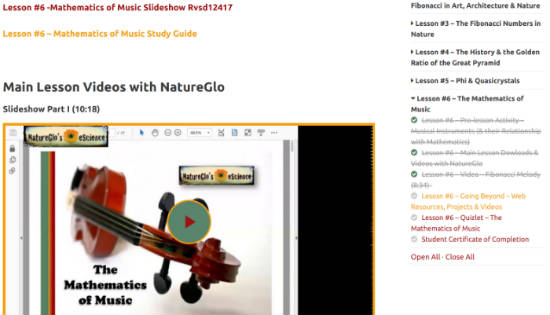
We usually watch the Main Lesson videos on Monday. During the rest of the week, we follow the flow of the lesson. On Tuesday and Wednesday we do one or two readings, activities, or other lesson components. The girls do not complete every activity; if they are not excited about it, we just skip it and move on.
Most weeks, Gloria recommends supplementary resources that give a different perspective on the topic or go into greater depth. She provides links to these online sources and gives general guidance on how to use them. Some of them are too complex for the twins to understand, but there are always interesting videos or interactive sites to check out. I allow the girls to choose the ones that look most interesting to them. We spend a couple days each week investigating the supplementary material.
At the end of each lesson, a Quizlet game helps students master concepts as they match terms and definitions in a race against the clock. The girls repeat the Quizlet again and again, trying to beat each other’s best time.
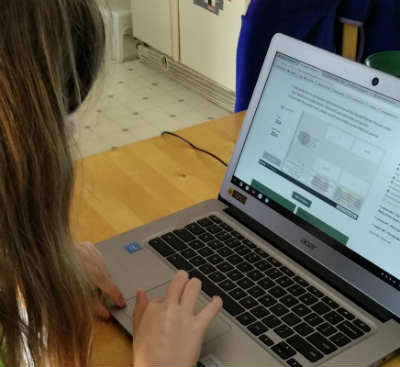
The course has templates for a lapbook and suggestions for a final project, but I did not assign these.
Fun Hands-On Activities
I usually shy away from hands-on activities, but this course is loaded with them. Am I requiring any? No. Am I encouraging all of them? No. Do I ask the girls to try a few that seem pretty doable? Absolutely! Are they doing more than I expected? They certainly are!
During the first week, they used calculators to compute the golden ratio, phi.
The following week, they were inspired to build an origami icosahedron, using instructions from my older son’s Unit Origami book. Their efforts failed, but they were able to build a cube!
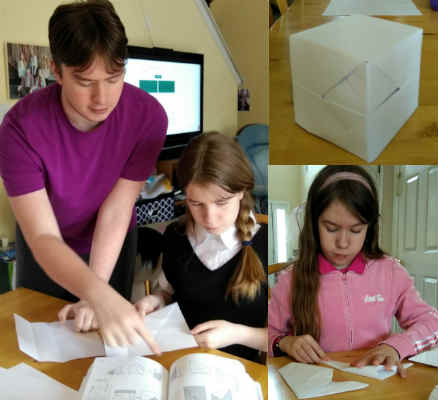
The girls really enjoyed the third week. They counted petals, leaves, and sepals on Valentine’s Day roses in search of Fibonacci numbers.
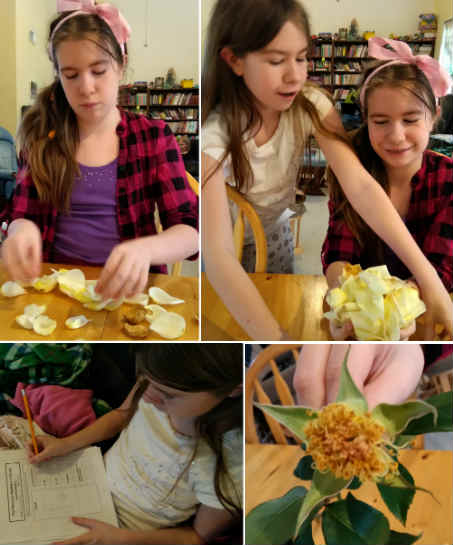
One of the videos inspired them to draw golden spirals.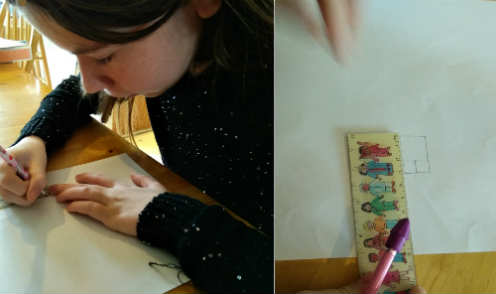
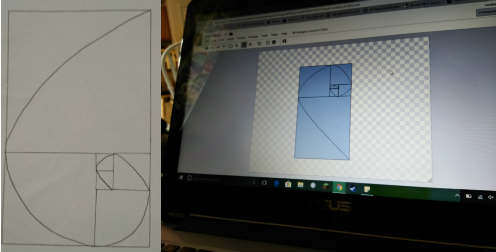
After watching a video that demonstrated using the golden angle to draw realistic-looking flowers with mathematically-spaced petals, they had to try it themselves.
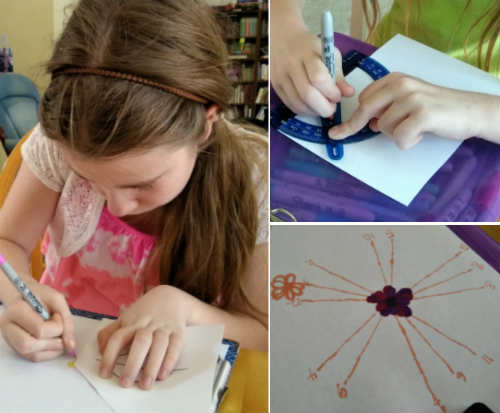
Week five’s topic was quasicrystals, which were fascinating. I had never heard of them before. My son, a high school senior who excels in math, took a break from his own schoolwork to listen on his younger sisters’ lesson. They all experimented with the pattern blocks they used in preschool to see if they could come up with any cool quasicrystaline structures. I do not think it was possible given the standard sizes of their materials, but they sure had fun!
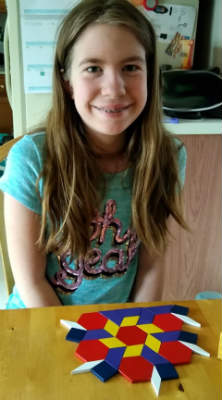
What the Kids Love
My daughters knew about Fibonacci numbers before the course, but they enjoy learning more about them. The information about the Golden Number and the Golden Spiral was completely new to the twins.
Both girls are thrilled to complete math exercises that do not require paper. They have fun interacting with other websites and using calculators to make complex calculations.
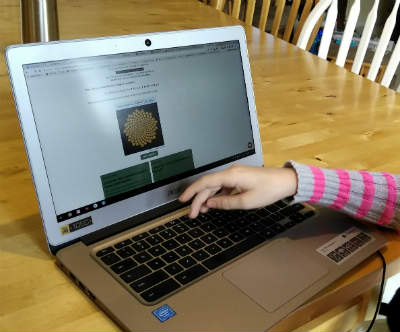
MathArt has brought hands-on activities back into our homeschool. I watch twin faces light up as my daughters explore math concepts using all of their senses. The course is truly interdisciplinary, weaving together history, science, math, art, music, architecture, and even literature.
Gloria provides an abundance of material to choose from. In my younger homeschooling days, this may have overwhelmed me, but over the years I have learned to be the master of the curriculum rather than letting it master me. I keep reminding myself that we do not have to complete every aspect of the course. We simply focus on the many activities that appeal to the girls.
What They Love Isn’t Always What I Love
Although the twins heartily enjoy MathArt, I have mixed feelings about the course. It bothers me that the pages load slowly. The lesson pages are so full of information that sometimes it is easy to miss a helpful resource. When we were starting out, I overlooked the study guide and the second video in the main lesson.
The material in the MathArt classes is fascinating, but the concepts can be difficult to grasp, challenging even my own mathematical mind. About half of the information Gloria includes can be understood by bright middle school kids, but some of the supplemental resources she links to are at the college level or beyond. It would be helpful if she would rate the difficulty level of those resources so I could easily tell which ones are suitable for my kids.
Determining how to schedule each activity is a challenge. Usually, I plan a week of lessons at a time, indicating which sections should be completed each day. I can not create an accurate daily schedule for this class since the activities vary in length and difficulty. Instead, we work together each day for as long as the girls want to; their brains tire quickly during some lessons, but at other times they engage with the material for an hour or more.
The recorded videos seem boring to me; a bit of editing could significantly improve them. In live classes, I expect long pauses while an instructor waits for a student to respond verbally with their mic. A difference in sound level and quality between a live instructor and her students is understandable. However, these extended pauses and volume fluctuations are distracting and annoying during the recorded classes. My son, who edits videos at our church, suggested that with video editing software, Gloria could turn the sound up to improve certain parts of the videos and edit out long pauses to make these recordings more professional.
Even though we have all learned so much from the MathArt class, I doubt I would ever purchase it for our homeschool. The style does not mesh well with the way I normally homeschool, and the topics covered, though fascinating, are not ones I would typically include in our curriculum. In addition, I would not be able to afford the cost of the class. Each 6-week class sells for $149; purchasing the 4-class Bundle offers 10% savings but still totals to $536.40 for one year of access.
Who Would Benefit From MathArt?
Aside from the price and technical issues, MathArt is a great supplementary resource. I recommend it for middle school students like my twins, who are ahead of most of their peers in math. It introduces complex topics in a way that preteens and young teens can understand. Families who enjoy unit studies will appreciate the way MathArt incorporates various disciplines.
High school students could use the course independently as well; I would expect them to read more of the material, complete additional activities, and turn in a final project for each 6-week session.
Math Connections with the Real World does a good job of introducing mathematical ideas students may not come across anywhere else in their studies but which flow like undercurrents through the world around them. This wonderful supplementary class brings together math with other subjects my twins love—nature, art, and music. The smiles on their faces as they explore MathArt say so much, and their enthusiasm is contagious. Both girls are looking forward to exploring some of the other classes Gloria offers at NatureGlo’s eScience.
Click here to read more reviews of the MathArt 4-Class Bundle

